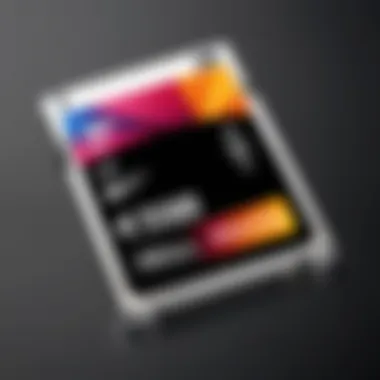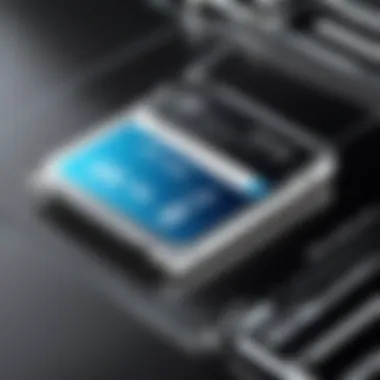Understanding 4GB CF Cards: Specifications & Uses


Intro
CompactFlash (CF) cards have been a mainstay in the world of digital storage, especially in relation to photography and data transfer tasks. The 4GB option, while appearing modest by today’s standards, presents a specific niche. Understanding this type of storage can be beneficial for tech enthusiasts and casual users. By examining the specifications and applications of 4GB CF cards, one can appreciate their place in the technology landscape.
In the upcoming sections, we will delve deeper into the product overview, performance analysis, installation processes, the pros and cons of using these cards, and finally, key insights for potential buyers. This comprehensive guide will equip users with the knowledge needed to navigate their options effectively.
Product Overview
Key Features
4GB CompactFlash cards are designed with portability and reliability in mind. They enable quick data transfer and are relatively durable. Key features of these cards include:
- Compatibility: Fits a range of devices, primarily cameras and certain audio recorders.
- Speed: Often capable of moderate data write and read speeds, suitable for standard photography needs.
- Durability: Built to withstand wear and tear, suitable for outdoor usage.
Technical Specifications
Understanding the technical specifications is paramount. Here are crucial details:
- Capacity: 4GB.
- Interface: CF Type I or Type II depending on the model.
- Speed Class: Varies by manufacturer, but usually suitable for HD video and large image file storage.
- Form Factor: Compact, designed to fit in standard CF slots, making them a practical choice for legacy equipment.
Pricing Information
The price range of 4GB CF cards is generally modest when compared to higher-capacity options. Prices typically fall between $5 to $20, depending on the brand and specific features. Popular brands include SanDisk and Lexar, which are known for their reliability.
Performance Analysis
Benchmark Results
In testing conditions, 4GB CF cards generally perform well. Read and write speeds can reach up to 40 MB/s in ideal scenarios. Benchmarks can vary greatly based on the device used and the specific brand of the card.
Real-World Use Cases
Several use cases remain relevant for 4GB CF cards:
- Photography: Suitable for casual photographers using older models of cameras.
- Music Production: Some audio devices still utilize CF cards for recording.
- Data Transfer: For transferring smaller files where high capacity is not necessary.
Comparison with Competitors
When comparing 4GB CF cards to other formats like SD cards, it’s important to note the differences in form factor and speed capabilities. While SD cards can often offer higher speeds and capacities, CF cards maintain a unique appeal due to their robustness and compatibility with older technology.
Installation and Setup
Required Tools and Components
Setting up a 4GB CF card usually requires the following:
- The CF card itself.
- Compatible device (camera, audio recorder).
- Optional: Card reader for data transfer.
Step-by-Step Installation Guide
- Insert the CF card into the appropriate slot of the device.
- Ensure a firm connection to avoid misreads.
- Format the card if the device prompts for it before use.
Troubleshooting Common Issues
Common issues can include:
- Card Not Recognized: Check the slot for debris.
- Format Errors: Reformat the card using the device settings.
- Slow Performance: Ensure your device supports the card’s speed class.
Pros and Cons
Advantages of the Product
- Reliability: Less susceptible to damage than some other card types.
- Legacy Support: Works well with older technology not designed for newer formats.
- Cost-Effective: Generally more affordable compared to higher-capacity options.


Disadvantages or Limitations
- Storage Capacity: Limited to 4GB, which may not suffice for larger files or high-resolution images.
- Speed: While decent, it may lag behind modern SD variants.
Who It’s Best Suited For
This compact card is ideal for:
- Casual photographers.
- Individuals using older electronic devices.
- Those needing basic file transfer without the necessity for high capacity.
Final Thoughts
Summary of Key Points
In summary, 4GB CompactFlash cards occupy a unique position in the landscape of digital storage. They cater to specific user needs, primarily those involving older devices and simple storage requirements.
Recommendations for Potential Buyers
When considering a purchase, assess your device compatibility and personal needs. The modest cost makes it a low-risk investment for specific applications.
Future of the Technology or Product Line
The future for CF cards may see them becoming less common with advancements in SD technology. However, for those who value legacy support, these cards will retain their relevance.
Foreword to CompactFlash Technology
CompactFlash (CF) technology holds a key position in the realm of digital storage solutions. Its significance can be attributed to various features and functions that appeal to both casual users and professionals. In this section, we will explore the fundamental aspects of CF cards, presenting a solid foundation for understanding the 4GB option.
Overview of Memory Card Formats
Memory cards have evolved significantly over the years. Different formats serve various purposes based on their specifications and intended use cases. CompactFlash is just one of the formats among several options available, such as SD, microSD, and others. Each format has its own set of advantages and limitations.
CF cards are particularly known for their robust design and large capacities. They have traditionally been favored in professional scenarios, especially photography and videography, where speed and reliability are critical.
- CompactFlash cards come in two types: Type I and Type II, differing in thickness.
- The standard sizes and speeds can cater to diverse needs, making them versatile.
- Their durability, due to the bulkier design, is also a notable advantage.
As we delve deeper into the characteristics of 4GB CF cards, it is important to recognize their role among various memory formats. This understanding provides a clearer picture of how they fit into the broader landscape of storage solutions.
History and Development of CF Cards
The journey of CompactFlash cards began in 1994. Initially developed by Sandisk, CF cards were introduced as a solution to the growing demand for portable storage. Their design was aimed at providing a fast, fail-safe, and compact alternative to earlier storage methods.
Over the years, CF cards have undergone several developments.
- Speed Improvements: From their inception, the speed classes increased, enabling faster data transfer rates.
- Capacity Expansion: While the 4GB option may seem modest today, earlier versions maxed out at much lower capacities. Cards now can reach capacities of up to several terabytes.
- Adoption: CF cards started appearing in high-end cameras and other devices where performance matters, solidifying their place in the market.
Despite facing competition from newer technologies, CompactFlash has maintained relevance. The continuing development reflects a commitment to enhancing durability, speed, and overall performance. This historical context enriches the understanding of the 4GB option, forming a bridge between technological evolution and practical applications.
The Specifications of a 4GB CF Card
Understanding the specifications of a 4GB CompactFlash (CF) card is crucial for both tech enthusiasts and casual consumers. These specifications guide users in making informed choices tailored to their needs. Knowing memory capacity, transfer speeds, and physical attributes can greatly affect performance, usability, and compatibility with devices.
Memory Capacity Explained
The memory capacity of a CF card directly impacts how much data can be stored. A 4GB CF card might seem limited when compared to larger options available today. However, for specific applications, such as storing JPEG images at moderate resolution or short video clips, 4GB can effectively meet requirements. Users should evaluate their storage needs based on factors like file sizes and types. For example, while high-quality RAW images from cameras demand more space, typical everyday use may not.
Transfer Speeds and Performance Metrics
Transfer speeds are critical for understanding how quickly data can be read from or written to the CF card. A 4GB CF card typically supports certain speed classes that dictate performance. Users should be aware of these metrics as they can significantly affect the efficiency of tasks such as saving photos or loading data from the card. Higher speed classifications, like UDMA (Ultra Direct Memory Access), enhance performance during file transfers. This ensures quicker read times and reduced lag, particularly in demanding situations like recording high-definition video.
Physical Dimensions and Form Factor
The physical dimensions and form factor of a 4GB CF card are standardized to fit within designated slots. Most CF cards measure 43mm x 36mm, allowing for easy integration into compatible devices. However, potential users should check device specifications to confirm compatibility, as not all equipment supports CF cards. The robustness of these cards is an advantage, providing durability in various environments. This characteristic is significant for users in photography or fieldwork, where harsh conditions might threaten device integrity.


"Focusing on the specifications of 4GB CF cards enables users to ensure their technology aligns with intended uses, enhancing performance and satisfaction."
In summary, the specifications of a 4GB CF card—memory capacity, transfer speeds, and physical dimensions—play a vital role in determining its usability across different applications. By understanding these aspects, users can better match their storage solutions to their specific needs.
Applications of 4GB CF Cards
CompactFlash (CF) cards are renowned for their versatility in various applications. The 4GB CF card, in particular, serves essential roles in multiple fields, making it a valuable resource for many users. This section aims to illustrate the significance of these cards, showcasing their utility in photography, industrial applications, and embedded systems. Understanding these applications can help users appreciate the relevance of the 4GB CF card in today's tech-driven world.
Usage in Photography and Videography
Photographers and videographers often require reliable storage solutions. The 4GB CompactFlash card stands out due to its good balance of capacity and performance. It allows the storage of numerous high-resolution images or videos without needing constant switching between cards. For instance, a DSLR camera can capture thousands of JPEG images with a 4GB card, making it suitable for events like weddings or sports, where capture rate is critical.
Moreover, the write speeds of these cards can cater to burst shooting modes, minimizing the delays between shots. This feature is crucial for professional photographers capturing fast-moving subjects. The durability of CF cards also means they can withstand harsh conditions, making them ideal for outdoor shoots.
Role in Industrial and Medical Devices
In industrial settings, the adaptability of 4GB CF cards shines. They are often employed in various devices, including data loggers and controllers. Their ability to store essential operational data makes them crucial for maintaining efficiency in processes.
In medical applications, these cards store critical information in devices such as imaging systems and diagnostic machines. They must meet strict requirements for reliability and data integrity since the information might be life-saving. Due to their robustness, 4GB CompactFlash cards are well-suited to these demanding environments.
Implementation in Embedded Systems
Embedded systems often require compact yet effective data solutions. The 4GB CF card provides a reliable option for storing firmware updates, log files, and data configurations. These cards are prevalent in consumer electronics as they offer low power consumption combined with adequate storage.
Engineers often choose CF cards for their compatibility with numerous systems, ensuring seamless integration into various applications. The cost-effectiveness of 4GB cards makes them an appealing choice when developing prototypes or products requiring minimal storage capabilities.
In summary, the applications of 4GB CF cards are diverse and encompass critical areas such as photography, industrial usage, and embedded systems. Their unique features contribute greatly to their utility in these fields.
The insight into these applications provides clarity on why users frequently opt for 4GB CF cards, reinforcing their invaluable role across different sectors.
Advantages of 4GB CF Cards
The 4GB CompactFlash (CF) card provides several benefits, making it a suitable choice for various users. Understanding these advantages helps consumers make informed decisions when selecting storage options. Here are the primary advantages of 4GB CF cards:
Cost-Effectiveness for Entry-Level Users
For individuals new to photography or those who use digital devices infrequently, 4GB CF cards represent a financially wise choice. Unlike larger capacity cards, they usually come at a lower price. This low-cost option aligns well for users who may not require vast storage space. For instance, someone using it in a point-and-shoot camera or an older device will find that 4GB is often ample. An entry-level user will appreciate this budget-friendly option.
Robustness and Durability
One key feature of 4GB CF cards is their durability. Designed to endure harsh environments, these cards can withstand more severe conditions than typical SD cards. Their solid build protects against shocks, extreme temperatures, and moisture. Such robustness is crucial for professionals working in demanding situations, such as outdoor photography or industrial applications. Users can trust that their data remains safe, which adds to the overall appeal of 4GB CF cards.
Compatibility with Various Devices
4GB CF cards are compatible with a range of devices. Many older cameras, camcorders, and industrial equipment rely on this format. Even though technology continues to evolve, several devices still accept CF cards seamlessly. Users benefit from this wide compatibility, ensuring their devices can still utilize the storage option without needing a complete upgrade. This makes the 4GB CF card a reasonable choice for those with vintage or specialized technology.
The blend of affordability, durability, and compatibility makes the 4GB CF card an appealing option for a wide array of users.
Overall, the advantages of 4GB CF cards cater to users who prioritize cost, durability, and device compatibility.
Limitations of 4GB CF Cards
Understanding the limitations of 4GB CF cards is crucial for users who are considering these memory cards for their devices. While they provide certain advantages, it's essential to recognize the drawbacks to make informed decisions. This section covers two primary limitations: storage capacity and write speeds under various conditions.
Storage Limitations Compared to Larger Cards
4GB is increasingly seen as a small capacity in today's market. As digital content becomes larger, the need for more storage is inevitable. For example, high-resolution photos and 4K video files demand significantly more space than they did in the past. Users wanting to shoot continuously or capture long videos may find that a 4GB CF card fills up quickly. As a result, they may need to carry multiple cards or constantly transfer files to storage devices, which can be inconvenient.
Consider the following points regarding storage limitations:
- Higher Resolution Formats: Modern DSLR and mirrorless cameras can produce images that are 20MB or larger. At that rate, a 4GB card could hold only about 200 images. This number drastically reduces when video recording is involved.
- Limited Versatility: If users intend to switch between photo and video functions, they might find 4GB restrictive. Considering a card with at least 16GB or even 32GB may be more practical.
- Incompatibility with Large Applications: If a user wants to run applications like high-end game emulators or software requiring higher data rates, 4GB may simply not suffice.
Slower Write Speeds Under Certain Conditions


While some may find the transfer and read speeds of 4GB CF cards adequate, write speeds are often a critical factor, especially during high-performance tasks like continuous shooting. Slower write speeds can lead to lag and missed shots in rapid sequences. Users need to be aware of the situation:
- Buffer Limitations: When shooting in burst mode, if the write speed doesn’t keep up with the camera’s demands, it can result in a bottleneck. This often forces the user to wait before capturing the next shot.
- Quality of Card: Not all 4GB CF cards are created equal. Some cards perform well but can be slower than their larger counterparts, which are designed to handle higher data traffic.
- Environmental Factors: Heat can also impact performance. In hot conditions, write speeds may decrease further, affecting overall usability during lengthy shoots.
"When considering a memory card, know your demands first. Paying attention to storage and write speeds can make a substantial difference."
Balancing between the limitations and performance expectations is vital when selecting a 4GB CF card. Knowing these limitations allows users to better prepare for their storage needs.
Comparing CF Cards to Other Memory Formats
Understanding how CompactFlash cards compare to other memory formats is crucial for consumers and tech enthusiasts. Each format has its unique characteristics, offering different benefits and limitations. By comparing CF cards with options like SD cards and SSDs, users can make more informed choices about their storage solutions. This understanding can enhance the user experience, ensure compatibility, and fit individual storage needs whether for professional use or casual applications.
CF vs. SD Cards: A Direct Comparison
When looking at CF cards in relation to SD cards, several factors come into play. These two formats cater to different audiences and use cases, primarily defined by their design and performance.
- Form Factor and Size: CF cards are larger than SD cards. The physical size can influence device compatibility. Cameras designed for CF cards often have more significant space internally, but many modern devices favor the smaller SD format, which is easier to fit in compact devices.
- Performance Specs: Generally, CF cards can offer better sustained read and write speeds compared to standard SD cards. They often support a higher capacity despite limited options at the 4GB level. In contrast, newer SD cards offer high speed ratings meant for fast transfers, particularly in high-definition video recording situations.
- Durability: CF cards are typically more robust under harsh conditions due to their design and construction. On the other hand, while SD cards are less durable, advancements in technology have made them more resilient than before.
Choosing between CF and SD cards comes down to the specific needs of the user. A photographer might prefer a CF card for its speed and durability, while a casual user may find an SD card more versatile and easier to use.
Performance Comparison: CF Cards and SSDs
When comparing CF cards with SSDs, the analysis shifts toward speed and scalability in storage capacities.
- Speed Metrics: SSDs generally outperform CF cards in terms of read/write speeds. They utilize NAND flash technology, which provides ultra-fast access times crucial for applications demanding high data bandwidth. On the other hand, while large capacity CF cards can be quite quick, they still lag behind dedicated SSDs, mainly designed for high-performance tasks.
- Storage Capacity: SSDs also provide a wider range of storage capacity options. A 4GB CF card may serve well for lightweight applications or specific tasks, but SSDs are ideal for heavy-duty workloads needing vast amounts of storage without the need for frequent switching out.
- Use Cases: The environments in which they operate also differ. CF cards are often found in cameras and some industrial devices, putting emphasis on portability and robustness. In contrast, SSDs are predominantly in computing environments where speed and storage space are the primary concerns.
In summary, while CF cards have their merits, notably in specific photography and industrial applications, SSDs offer superior performance and capacity for modern computing needs. These comparisons underline the importance of selecting the right storage medium based on users’ unique demands.
Future of CompactFlash Technology
The future of CompactFlash technology is an essential topic as it highlights the ongoing developments and innovations in the memory storage domain. CompactFlash cards, particularly the 4GB option, may not hold the same prominence as they once did. However, understanding their future can guide tech enthusiasts and consumers in making informed decisions on storage solutions.
The relevance of this discussion extends beyond simple updates; it also encompasses evolving consumer needs and market trends. With larger capacity cards readily available, the focus is shifting toward durability, speed, and specialized uses. As technology progresses, there are still niches where CompactFlash remains invaluable, particularly in professional photography and medical devices.
Emerging Trends in Data Storage
Recent advancements in data storage show a clear trend toward increasing capacities and higher transfer speeds. However, CompactFlash technology often caters to specific markets that prioritize reliability and performance.
- Speed Optimization: There is a rise in demand for storage solutions that balance capacity with speed. As data-intensive applications proliferate, users are interested in memory cards that can handle larger files quickly. CompactFlash technology sometimes provides specific optimization that benefits heavy users, particularly in advanced photography setups.
- Low-Power Consumption: Another trend is the focus on energy efficiency. Data storage solutions that consume less power become increasingly desirable, especially in portable and embedded systems. CompactFlash is adapting to these needs with newer design elements.
- Integration with Cloud Technology: With the advent of cloud storage options, users now desire hybrid solutions. Thus, the future may see CompactFlash technology collaborating with cloud services for seamless data backup and accessibility.
Potential Upgrades and Innovations in CF Technology
The potential for upgrades in CompactFlash technology lies in its ability to adapt and implement innovations relevant to modern demands. Several noteworthy areas warrant attention:
- Enhanced Data Security: As the need for data protection rises, newer versions of CF cards may incorporate advanced encryption and security features. Users will benefit from increased safety in their file storage, especially in sensitive sectors.
- Improved Durability: Many CompactFlash cards already have robustness against physical shock and environmental factors. Future iterations are likely to strengthen this durability even further, especially for industries like military and medical fields where reliability is non-negotiable.
- Increased Compatibility: As technology evolves, so too must memory cards. Future research and development could enhance compatibility with various devices. This increase could make these cards appealing for both old and new equipment.
Epilogue
The conclusion of this article emphasizes the importance of understanding 4GB CompactFlash cards, especially in an era where storage solutions continue to evolve rapidly. A concise understanding of the specifications, applications, advantages, and limitations of these cards equips users with information necessary to make informed choices based on their individual needs.
Summarizing Key Insights
To summarize the key insights: 4GB CF cards serve several roles across diverse fields, especially in photography, video recording, industrial operations, and embedded systems. These cards provide reliable performance and durability while maintaining a cost-effective option for entry-level users.
- Versatile Applications: They are not just suited for photographers; they also hold significant value in medical devices and industrial setups.
- Compatibility: 4GB CF cards offer compatibility with both older and newer devices, providing ease of use and integration.
- Cost-Effectiveness: For users with modest storage needs, these cards present a cost-efficient solution without compromising on quality.
Despite their limitations, such as slower write speeds and capacity restrictions when compared to larger models, they remain a relevant choice in many situations. A deep dive into their pros and cons is necessary to appreciate their place in digital technology.
Making an Informed Decision
When making a decision regarding the purchase of a 4GB CF card, one must consider various factors:
- Storage Needs: Assess your actual storage requirements. If you shoot in high-resolution or work with large files, a larger capacity card might be more appropriate.
- Device Compatibility: Ensure that your device supports CF cards, as some modern devices may prefer more contemporary memory formats.
- Budget Constraints: Balance your needs with your budget. While there are cheaper options, investing in a reliable brand could save costs in the long run.
- Performance Characteristics: Look for information on the read and write speeds, especially if you plan to use the card in high-demand situations like rapid photography.
Understanding these elements helps steer your purchase towards maximizing performance and ensuring longevity. Additionally, staying informed about advancements in CF technology and storage trends can empower you to make decisions that align with your long-term tech goals.
"Knowledge is power when it comes to choosing the right memory card for your needs."
In summary, knowing the features and limitations of 4GB CompactFlash cards facilitates better decision-making for both casual users and tech enthusiasts.



